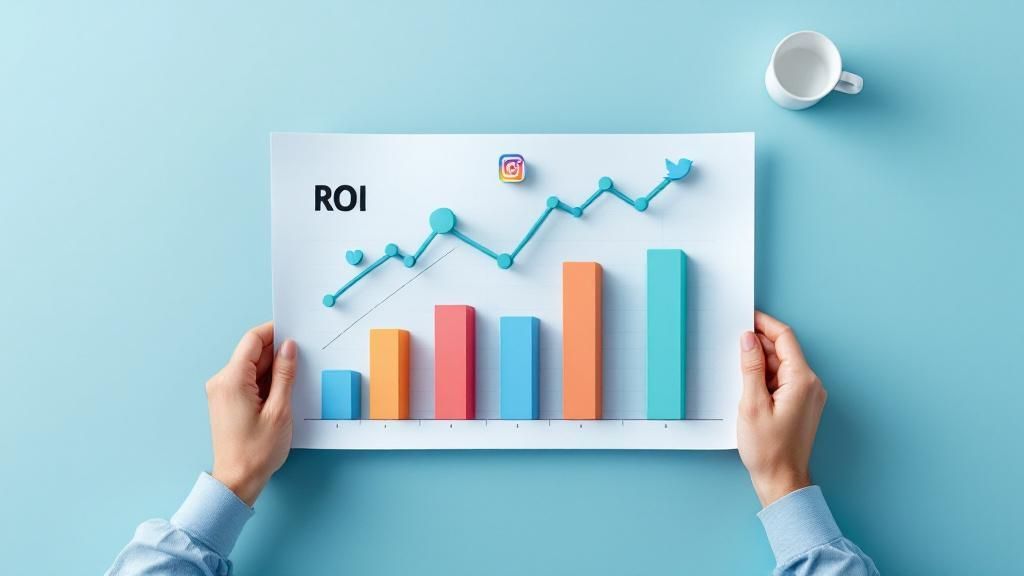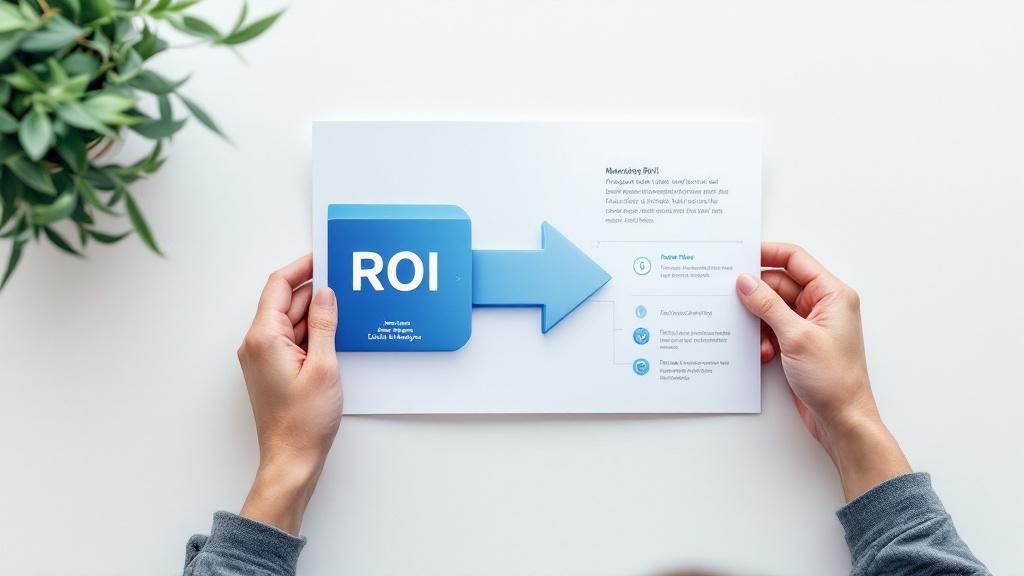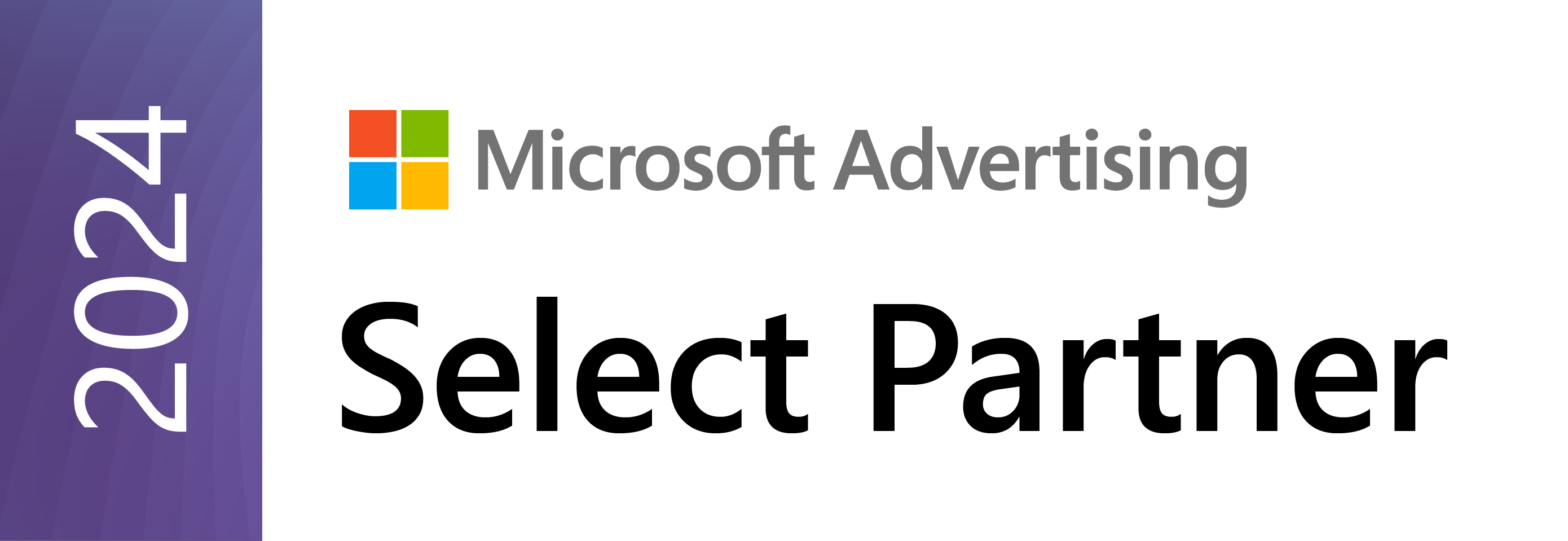
Social Media Marketing ROI: Turning Engagement Into Measurable Growth
Key Takeaways
-
ROI in social media marketing measures how effectively your investment in platforms translates into tangible business results.
-
A clear strategy with defined KPIs is essential for tracking success and optimizing campaigns.
-
Engagement metrics like likes and shares are important but must connect to bottom-line growth.
-
Businesses can maximize ROI through audience targeting, content optimization, and conversion-focused strategies.
-
Partnering with experts ensures your social media investments deliver measurable, sustainable results.
Social media has evolved from being just a platform for brand visibility to a core driver of sales, lead generation, and customer loyalty. For business owners, the most important question isn’t simply “How many followers do we have?” but “How much revenue is our social media strategy generating?”
ROI—Return on Investment—measures how effectively your social media spend turns into tangible outcomes. Whether your goal is to increase conversions, generate qualified leads, or grow brand recognition, understanding ROI ensures your efforts aren’t just “posting for the sake of posting.”
A well-measured ROI allows you to:
-
Identify which platforms and campaigns deliver the best returns.
-
Optimize budget allocation for maximum impact.
-
Present clear results to stakeholders or decision-makers.
-
Refine strategies to stay ahead in competitive markets.
The Common Misunderstanding About Social Media ROI
Many businesses mistake vanity metrics for ROI. High engagement rates—likes, comments, shares—feel good but don’t always translate to revenue. For instance:
-
10,000 likes on a post about a product mean little if none of those interactions lead to sales.
-
A viral video might bring visibility but no measurable conversions if the audience isn’t targeted correctly.
The key is connecting engagement to actual business growth. A business should measure success based on whether social media activity is influencing purchases, sign-ups, or other valuable actions.
Defining ROI for Your Business
There’s no one-size-fits-all formula for social media ROI—it depends on your objectives. However, a common calculation is:
Social Media ROI = (Value Gained – Cost of Investment) / Cost of Investment × 100%
Where:
-
Value Gained could be sales revenue, new customer sign-ups, or increased lifetime value.
-
Cost of Investment includes ad spend, content production, tools, and labor.
Example:
If you invest $2,000 into Facebook ads and generate $6,000 in new sales from them, your ROI is:
($6,000 – $2,000) / $2,000 × 100% = 200%
Setting the Right KPIs
To accurately track ROI, you need clear Key Performance Indicators (KPIs) that match your goals. Examples include:
-
Sales Revenue: Directly attributable to campaigns.
-
Lead Generation: Number of qualified leads from social media forms or landing pages.
-
Conversion Rate: Percentage of social visitors completing a desired action.
-
Customer Retention: Repeat business from social-driven customers.
-
Website Traffic: Social channels driving targeted visitors.
Building a Social Media Strategy That Delivers ROI
1. Identify Your Target Audience
Knowing exactly who you’re speaking to ensures your content resonates. Use audience insights tools on platforms like Facebook, Instagram, and LinkedIn to understand demographics, interests, and online behavior.
2. Create High-Value Content
Content must be:
-
Relevant: Speak to your audience’s needs and pain points.
-
Engaging: Encourage comments, shares, and saves.
-
Conversion-Driven: Include calls-to-action that guide users toward your desired outcome.
3. Choose the Right Platforms
Not every platform will give you the same ROI. For example:
-
B2B companies may find more value in LinkedIn campaigns.
-
B2C brands might thrive on Instagram, Facebook, or TikTok.
4. Leverage Paid Advertising
Organic reach is limited on most platforms. Paid ads allow precise targeting based on interests, demographics, location, and behavior—helping you reach people most likely to convert.
5. Track and Optimize
Regularly review performance metrics to identify top-performing content and campaigns. Adjust budgets, targeting, and messaging based on data, not assumptions.
Turning Engagement Into Conversions
Engagement is a necessary step toward ROI, but it’s not the end goal. Here’s how to bridge the gap:
-
Include Clear CTAs: Every post should direct users toward the next step—whether that’s visiting a product page, signing up for a webinar, or downloading a guide.
-
Retarget Interested Users: Use pixel tracking to re-engage users who interacted with your content but didn’t convert.
-
Offer Value-Driven Incentives: Discounts, free trials, or exclusive content can nudge engaged users toward becoming customers.
Measuring Beyond the Sale
ROI isn’t only about immediate sales. Long-term brand value also plays a role:
-
Customer Lifetime Value (CLV): If a new customer from social media continues to buy from you over years, their value extends beyond the first purchase.
-
Brand Advocacy: Social campaigns can create loyal customers who recommend your brand—generating referrals without direct ad spend.
-
Market Insights: Engagement data can guide product development and marketing strategies.
Avoiding Common ROI Pitfalls
-
Failing to Set Measurable Goals
Without specific targets, you can’t measure true success. -
Overlooking Attribution
If you don’t track where conversions are coming from, you won’t know if social media is the real driver. -
Ignoring the Funnel
Some campaigns are better suited for awareness, others for conversions. Mixing the two without strategy can dilute results. -
Not Testing
A/B testing ads, headlines, and visuals helps pinpoint what works best.
The Role of Expert Guidance
Managing social media ROI effectively requires both creative and analytical skills. Businesses often struggle with balancing content creation, ad management, and data analysis. Partnering with an experienced digital marketing team can streamline the process and amplify results.
A trusted agency like CS Design Studio offers:
-
Data-driven campaign planning.
-
Platform-specific content strategies.
-
Precision targeting for paid ads.
-
Continuous monitoring and optimization.
This ensures that your investment produces measurable, lasting impact.
When to Reassess Your Strategy
If you notice:
-
Declining engagement and conversions despite consistent posting.
-
High ad spend without proportional returns.
-
An unclear link between social activity and business outcomes.
…it’s time to revisit your KPIs, targeting, and messaging. Even small tweaks—like refining your audience or adjusting ad creative—can significantly improve ROI.
Final Thoughts
Measuring and maximizing social media ROI isn’t about chasing every trend or trying to be everywhere at once. It’s about aligning every post, ad, and interaction with clear business objectives, then tracking progress toward them.
By focusing on the right metrics, optimizing campaigns, and investing in expert guidance, your business can turn social media from a cost center into a revenue-driving powerhouse.
FAQs
What’s the ideal ROI for social media marketing?
It varies by industry and campaign goals. Some industries aim for 200–300%, while others focus more on customer lifetime value than immediate returns.
How often should I measure ROI?
At least monthly, though weekly check-ins can help you make quicker adjustments.
Can organic social media deliver good ROI without paid ads?
Yes, but it’s harder due to reduced organic reach. Paid ads often accelerate results.
Which platform delivers the best ROI?
It depends on your audience. B2B often thrives on LinkedIn, while B2C may see better returns from Instagram or Facebook.
Do follower counts matter for ROI?
Not directly. A smaller, highly engaged audience can generate more revenue than a large but inactive following.




